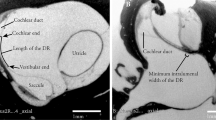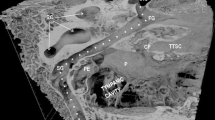Abstract
The vestibulocochlear organ is composed of tiny complex structures embedded in the petrous part of the temporal bone. Landmarks on the temporal bone surface provide the only orientation guide for dissection, but these need to be removed during the course of dissection, making it difficult to grasp the underlying three-dimensional structures, especially for beginners during gross anatomy classes. We report herein an attempt to produce a transparent three-dimensional-printed model of the human ear. En bloc samples of the temporal bone from donated cadavers were subjected to computed tomography (CT) scanning, and on the basis of the data, the surface temporal bone was reconstructed with transparent resin and the vestibulocochlear organ with white resin to create a 1:1.5 scale model. The carotid canal was stuffed with red cotton, and the sigmoid sinus and internal jugular vein were filled with blue clay. In the inner ear, the internal acoustic meatus, cochlea, and semicircular canals were well reconstructed in detail with white resin. The three-dimensional relationships of the semicircular canals, spiral turns of the cochlea, and internal acoustic meatus were well recognizable from every direction through the transparent surface resin. The anterior semicircular canal was obvious immediately beneath the arcuate eminence, and the topographical relationships of the vestibulocochlear organ and adjacent great vessels were easily discernible. We consider that this transparent temporal bone model will be a very useful aid for better understanding of the gross anatomy of the vestibulocochlear organ.



Similar content being viewed by others
References
Cuendet S, Bumbacher E, Dillenbourg P (2012) Tangible vs. virtual representations: when tangibles benefit the training of spatial skills. In: Proc. 7th Nordic conference on human–computer interaction: making sense through design, pp 99–108
George AP, De R (2010) Review of temporal bone dissection teaching: how it was, is and will be. J Laryngol Otol 124:119–125
Hochman JB, Rhodes C, Wong D, Kraut J, Pisa J, Unger B (2015) Comparison of cadaveric and isomorphic three-dimensional printed models in temporal bone education. Laryngoscope 125:2353–2357
Kuru I, Maier H, Muller M, Lenarz T, Lueth TC (2016) A 3D-printed functioning anatomical human middle ear model. Hear Res 340:204–213
Nicholson DT, Chalk C, Robert W, Funnell J, Daniel SJ (2006) Can virtual reality improve anatomy education? A randomized controlled study of a computer-generated three-dimensional anatomical ear model. Med Edu 40:1081–1087
Rose AS, Kimbell JS, Webster CE, Harrysson OLA, Formeister EJ, Buchman CA (2015a) Multi-material 3D models for temporal bone surgical simulation. Ann Otol Rhinol Laryngol 124:528–536
Rose AS, Webster CE, Harrysson OLA, Formeister EJ, Rawal RB, Iseli CE (2015b) Pre-operative simulation of pediatric mastoid surgery with 3D-printed temporal bone models. Int J Pediat Otorhinolaryngol 79:740–744
Sahni D, Singla A, Gupta A, Gupta T, Aggarwal A (2015) Relationship of cochlea with surrounding neurovascular structures and their implication in cochlear implantation. Surg Radiol Anat 37:913–919
Suzuki R, Konno N, Ishizawa A, Kanatsu Y, Funakoshi K, Akashi H, Zhou M, Abe H (2017) Time-saving and fail-safe dissection method for vestibulocochlear organs in gross anatomy classes. Clin Anat 30:703–710
Takahashi K, Morita Y, Ohshima S, Izumi S, Kubota Y, Yamamoto Y, Takahashi S, Horii A (2017) Creating an optimal 3D printed model for temporal bone dissection training. Ann Otol Rhinol Laryngol 126:530–536
Wong H, Northrop C, Burgess B, Lieberman MC, Merchant SN (2006) Three-dimensional virtual model of the human temporal bone: a stand-alone, downloadable teaching tool. Otol Neurotol 27:452–457
Acknowledgements
The authors are grateful to the individuals who donated their bodies after death, without any economic benefit, to Akita University Graduate School of Medicine for research and education on human anatomy. They also thank Mitsutaka Miura, Takahiro Obata, and Masami Kawagoe for technical assistance during this research. This study was supported by the Akita University Graduate School of Medicine.
Author information
Authors and Affiliations
Corresponding author
Ethics declarations
Conflict of interest
The authors declare that they have no conflicts of interest.
Rights and permissions
About this article
Cite this article
Suzuki, R., Taniguchi, N., Uchida, F. et al. Transparent model of temporal bone and vestibulocochlear organ made by 3D printing. Anat Sci Int 93, 154–159 (2018). https://doi.org/10.1007/s12565-017-0417-7
Received:
Accepted:
Published:
Issue Date:
DOI: https://doi.org/10.1007/s12565-017-0417-7




